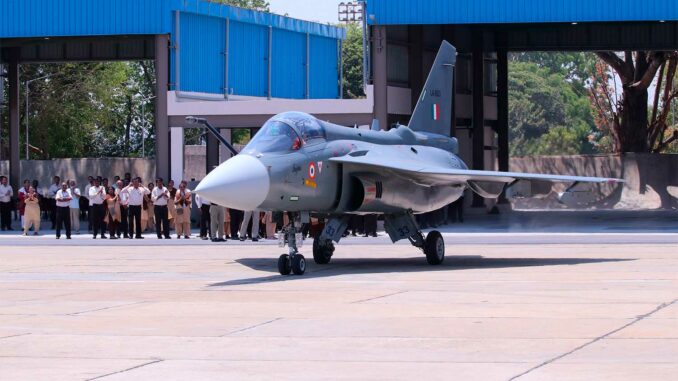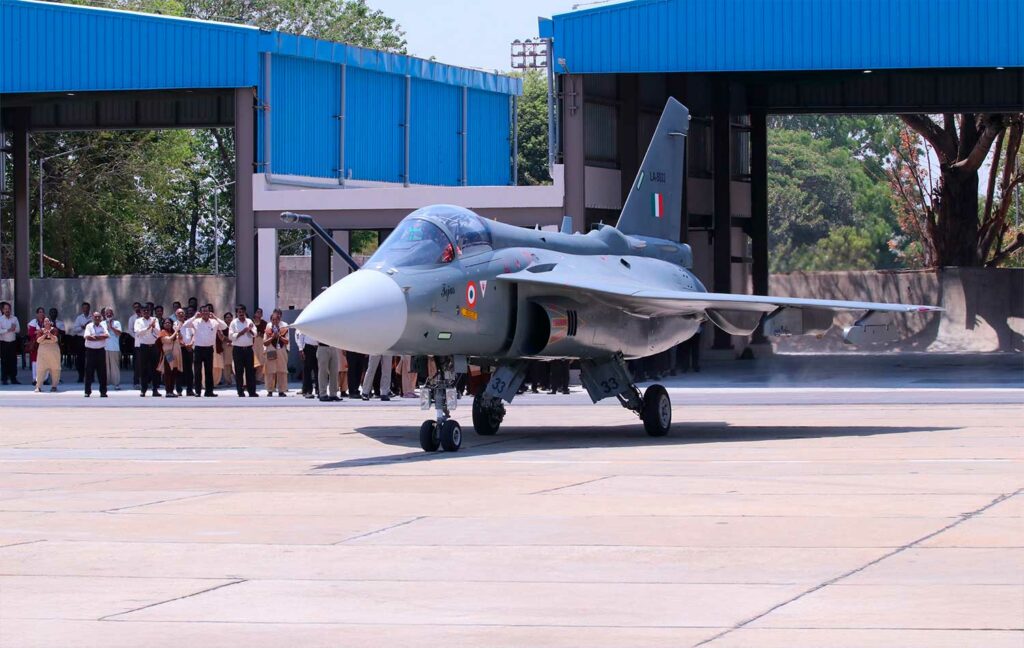
HAL surges after receiving order for 97 Tejas Mk1A aircraft (€7.0 billion). Production rates, deliveries between 2027 and 2033, financial impact, and analyst opinions.
Summary
The Indian Ministry of Defense has signed a firm contract for 97 LCA Tejas Mk1A aircraft with HAL, worth ₹62,370 crore (approximately €7.0 billion). The batch includes 68 single-seaters and 29 two-seaters, with deliveries starting in 2027-2028 and completion within six years. The manufacturer is relying on three production lines (two in Bengaluru and one in Nashik) to bring production up to 24 per year, a rate that is compatible with the schedule. Supply constraints for GE F404 engines, which caused delays in 2024-2025, are gradually easing. HAL’s order book exceeds ₹2.7 lakh crore, which supports cash flow visibility and attracts positive analysts (buy recommendations, targets between ₹5,800 and ₹6,220 per share). For the Indian Air Force, 97 additional Tejas bring the Mk1A total to 180, equivalent to about ten squadrons, reducing dependence on imports and reinforcing the Atmanirbhar Bharat trajectory.
The LCA Mk1A contract and its industrial parameters
The agreement signed in New Delhi sets out a clear framework: 68 single-seat combat aircraft and 29 two-seat training/transition aircraft, Buy (India-IDDM) category. The value of ₹62,370 crore corresponds to approximately €7.0 billion, representing an average cost of close to ₹6.4 billion per airframe, including support packages, tooling, and parts. The plan is for the first aircraft to be delivered in fiscal year 2027-2028, followed by a steady flow over six years. This phasing reflects the maturity of the Tejas Mk1A chain and the integration of sub-assemblies by partners (structures, harnesses, composite elements).
This contract follows the first batch of 83 Mk1As notified in 2021. The total (83 + 97) brings the operational target to 180 aircraft, a volume consistent with the Indian Air Force’s target format for gradually replacing MiG-21s and filling capability gaps. The Mk1A features a native AESA radar, a modernized electronic warfare suite, a helmet-mounted display, and secure data links. Powered by the GE F404-IN20, it remains easy to maintain, with an empty weight of around 6.6 tons, a maximum takeoff weight of close to 13.5 tons, and a range that meets the requirements for interception, support, and national air defense.
The political logic is clear: secure a national fleet at controlled costs, smooth out learning curves, and quickly transition to stable production rates. The six-year contract structure gives suppliers visibility, which is essential for meeting prices and deadlines.
Production and supply chain: pace, constraints, and solutions
Production of 24 aircraft per year is based on two lines in Bengaluru (16 units per year) and one line in Nashik (8 units per year). Investments in tooling (≈150 crore ₹ in Nashik), the industrialization of sections (rear and center fuselages delivered by Indian partners) and increased automated quality controls should reduce cycle times. HAL has formalized the stabilization of the Mk1A ranges with the first flight-line aircraft in 2025, subject to the delivery of the engines.
The sticking point has been engine throughput. After a delay in the first GE deliveries in 2024, the promised rate is around 12 engines in the first year, then 20/year. This level supports a delivery rate of 16 to 24 aircraft per year, depending on the prioritization of kits and the availability of equipment (AESA, EW, seats, computers). At the same time, HAL has increased the local integration of sub-assemblies (pylons, swing tanks, harnesses) to reduce exposure to import delays.
Financially, the order book exceeds ₹2.7 lakh crore, representing more than eight times annual revenue, a ratio typical of a multi-program series ramp-up (Tejas, ALH Dhruv, LCH Prachand, LUH). New Delhi is considering a targeted reorganization of HAL to accelerate flows (simplification of governance, consolidation of units, strengthening of project control). The objective is pragmatic: to remove bottlenecks (painting, testing, quality acceptance), make acceptance milestones more reliable, and shorten the order-delivery cycle.
On the supply chain side, standardization of references and “administrative cannibalization” (inter-line replanning) remain options for arbitration in the event of tension on a critical part. The challenge is to avoid “almost finished” aircraft that tie up working capital. The key will remain the regularity of GE engines and the robustness of avionics suppliers.

Market dynamics and capacity impact for the IAF
The stream of announcements had an immediate effect on HAL‘s share price. Over the course of a month, the share price rose by double digits; since January, the stock has gained around 14-15%. Several firms are raising their targets: Nomura maintains its buy rating at ₹6,100; local brokers are targeting ₹5,800 to ₹6,220, betting on the volume effect and cost discipline. These positive analysts are basing their outlook on three levers: revenue visibility over 7-8 years, improved margins as ramp-up progresses, and a high probability of additional business (helicopters, engines, MRO).
For the Indian Air Force, 180 Mk1As are equivalent to about ten squadrons (typical format of 16-18 aircraft plus reserves). The 2027-2033 schedule allows for planning the transition of units and absorbing crew-technician training without an operational “gap.” The first batches will serve as a basis for weapons qualification (Astra Mk1/2, guided bombs), network integration, and the rise of condition-based maintenance.
In the medium term, the alignment of the Tejas Mk1A, followed by the LCA Mk2 and AMCA, will create a complete supply chain. The learning effect on the Mk1A feeds into the Mk2 (GE F414 engine) and next-generation composite processes. The Atmanirbhar Bharat policy gains credibility when delivery milestones are met and costs remain contained. To say otherwise would be naive: if the engines or AESA suffer delays, the pace slows down. But with three production lines, better-sized inventories, and tighter state supervision, the operational risk is reduced.
On the export front, the equation remains open. A Tejas delivered in large numbers and on time lends credibility to offers to Asia and Africa. Without this, prospects will remain cautious. The contract for 97 aircraft is therefore more than just a volume: it is proof by series. In a context of under-equipment of the IAF (≈31 squadrons vs. target 42), every delivery counts. Successfully completing this batch at the target cost and at the announced pace would establish HAL as a competitive prime contractor vis-à-vis established manufacturers in the long term.
War Wings Daily is an independant magazine.